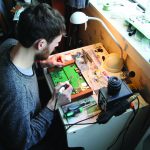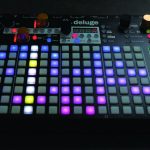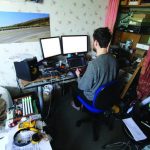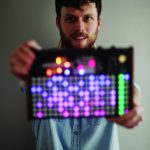Deluge: NZ’s Very Own World-leading Groovebox
Deluge: NZ’s Very Own World-leading Groovebox
Something new and exciting is coming to the world of electronic music – and what’s more it is coming out of our very own capital city. Seamus Maguire talked with Synthstrom Audible founder and creator of the Deluge, Rohan Hill, about how his personal DIY project ended up turning into a sophisticated professional piece of sequencer/synth hardware that may well prove a global hit.
Synthstrom Audible and its founder Rohan Hill may not be household names in the electronic music world – but they soon will be. The company’s about-to-be released first product – the Deluge – is an astonishingly comprehensive piece of gear. Initially starting out as a casual, almost naïve DIY project for Rohan to exercise his programming and electronics skills, it has slowly expanded into a world-class groovebox and sequencer that is a serious competitor to anything else on the market today.
Although the first production run has yet to be commissioned prototypes have been demonstrated in the US and Europe. Specialist synth dealers across the globe are reportedly eager to get retail quantities and plans are in place to exhibit the Deluge at the Las Vegas CES Show in January.
What makes the Deluge so impressive is the fact that it is almost entirely the result of Rohan’s own time and efforts. While other music gear companies like Novation or Korg hire teams of marketers to figure out what musicians want, and scores of electronic-engineers to design the gear, Rohan has managed to make something more interesting – and done so almost entirely on his own as the photos over the page illustrate – in the confines of his Wellington flat.
Rohan Hill’s history of hardware design and programming is of humble beginnings. He developed a good understanding of coding through studying for a Computer Science degree from Victoria University, and also gained a basic knowledge of electronics by way of a few DIY projects – such as building a guitar amp, making cables and programming the Arduino, a hobbyist microcontroller.
However even contemplating a project such as the Deluge requires a lot more than just a hobbyist’s understanding of electronics. He had to teach himself a wide range of new skills from programming commercial grade microcontrollers, writing the code for the synthesizer and effects from scratch, and also learning circuit-board design – something that really requires a degree in electrical engineering just to get your head around.
Rohan’s initial motivation to make the Deluge was not the result of noticing a gap in the music hardware market that he could fill, or of any commercially minded goals at all – instead it was a very personal desire to create a sequencer that he could use with his own music that would also pull him away from sitting in front of a computer screen. That was at the beginning of 2014. He’s been working on it, literally day and night, almost constantly since – around 7000 hours all up he guesses.
“The original philosophy and reason for making the Deluge was for getting sequenced music off the computer and out into the performance environment,” Rohan explains of the wider context. “I think a lot of people making electronic music in a live performance setting feel a bit limited being stuck behind the computer screen or having to edit on the screen if they wanted to do something like change the beat on the fly.”
His Deluge offers exactly that. It is a comprehensive sequencer, sampler, and synth engine (both subtractive and frequency modulation) with several onboard effects, with an intuitive programming and playing style. It’s very portable, has an internal microphone – along with mic and line inputs – and even has speakers. It has its own battery pack so you can play (with) it anywhere without the need of a power supply, and it has an astounding 128 back-lit silicone pads (that is twice as many as other competing tech like the Ableton Push) all while still managing to be smaller in size. It also has modern sequencing capabilities, being able to sequence the internal synth engine and sampler and also externally via MIDI and through a variety of clock, trigger and CV outputs.
Of course that’s not what it started out to be, indeed not even what the first working prototypes offered. A lot of these ideas were gained through listening to what his friends and fellow musicians asked out of a groovebox and sequencer. Rohan – thanks to the advice of Ian Jorgensen (aka Blink) – held early trials and demonstrations with electronic musicians and as a result has left no stone unturned – the Deluge is a very modern piece of gear.
Jorgensen seems to think so too. With all his work establishing A Low Hum in its various manifestations, organising tours, running Wellington’s Puppies bar/venue, writing books and challenging the music industry status quo, it’s fair to describe Jorgensen as a visionary. When he learnt about Rohan’s ventures into making the Deluge he was immediately eager to get on board and help in any way he could.
“After chatting to Rohan at a show at my old bar and hearing about this device I had a play a few days later and within minutes was writing songs on it. He told me he was only planning on making a couple of units for him and some friends, I don’t think he had any idea just how revolutionary a piece of equipment he’d made and I figured that if this old man could write songs after a few minutes, anyone could.”
It was mid-2015 Jorgensen came on board and they started looking at it as a genuine business project. Jorgensen already had some plans. It was his idea to get Rohan demoing the early version Deluge with electronic musicians in Wellington from its early stages so that he could get the important and necessary feedback to make sure it had everything a musician could want. He has since helped secure support and funding from Callaghan Innovation – the government agency supporting technology businesses in NZ – and just recently has spent a fortnight in Europe demoing the still-unreleased Deluge at a variety of events, private studios and synth retailers – expanding interest in the Deluge well beyond Wellington.
While Rohan remains humble about the quality of his work, Jorgensen sees the potential – his role from here on out as a promoter for the feature-laden groovebox will be a vital part of the success of the Deluge.
“I had no idea just how badly people have been waiting for a device like this until travelling around Europe. I did around 30 demos over a few weeks and people are rabid, it definitely ticks a bunch of boxes for people in their dream portable all-in-one device. It was always interesting to see exactly what features got people most excitable, sometimes things you don’t think are that special really give people a kick – though the Deluge’s ability to play at 10,000 BPM always generates a smile!”
One of the most interesting parts of the design of the Deluge is its ‘piano-roll’ style of sequencing. To the best of my (and Rohan’s) knowledge the Deluge is the only sequencer to offer a hardware sequencer in this style. With other sequencers a note is selected at a certain point in time in the sequence and then the necessary information such as pitch, note length and velocity can be entered or edited.
With the Deluge, the pads are laid out in a 16 x 8 array that allows for immediate visual feedback through a two dimensional display of sequencing where the horizontal axis represents time – both in terms of time divisions and note length – and the vertical axis represents pitch, whether that be indicated with a certain scale or chromatically.
This provides an immediate visual indication of what is happening musically. For example, you can see that the sequence is playing quarter notes with each note being an eighth note in length, and on top of this you can see what pitch each of those notes are.
A really smart feature is the ability to zoom in and out of sequences. This is handy as it allows for in-depth sequencing while also allowing for a broader look over the pattern as a whole. It also allows for easy movement from one part of the sequence to another.
Each sequenced track can be any length the user likes, allowing for complex polyrhythmic patterns – something that a lot of vintage and modern sequencers seem to overlook. This allows for intricate sequences that can be continuously changing. For example, the length of a track of hi-hats with certain accents could be 15 sixteenth notes, while the kick and snare could be a standard 4:4 – resulting in a continuously changing rhythmic pattern.
The Deluge’s ability to sequence external gear is very comprehensive. While MIDI sequencing is certainly a standard feature on any modern sequencer, the Deluge offers a vast range of sequencing for other kinds of external gear. With the rise of popularity of modular synths and a resurgence of interest in vintage gear that requires unusual methods of sequencing, the Deluge provides almost every method of sequencing imaginable.
Rohan went above and beyond to make sure all kinds of synths could be sequenced, his determinedly comprehensive research leaving no stone unturned.
“When I decided to add CV and gate I spent a lot of time researching because there are various standards and none of them are very standard at all in terms of different numbers of volts-per-octave and hertz-per-volt. It was very difficult, pretty much none of the vintage gear has a spec sheet on what voltages it accepts, so there was heaps of trawling through internet forums and reading up on all kinds of sites on all kinds of standards and what devices used them and what the exceptions are to the normal rules of how that stuff works in terms of devices that require non standard things.”
The very comprehensive synth engine on the Deluge was programmed by Rohan from scratch. (Think about it… Rohan did for a full month.)
“I spent September 2014 doing nothing but programming the basic synth engine. It had oscillators, envelopes, filters, FM, unison detune, ringmod, noise, flanger, and the Deluge’s extremely flexible patching / modulation engine. It has been constantly expanded and improved since then though, and the sample processing engine (which initially came later) is now part of the same engine.”
It features two oscillators with oscillator sync, ring modulation, unison, detune, portamento and an arpeggiator. What’s more the filter can also be both lowpass and highpass. The coding isn’t based on any previous synth but instead was programmed by Rohan from the ground up – a complicated and lengthy process.
“When I started looking at a synth engine and first decided that I wanted the Deluge to make sound I did look for open source synthesisers that I could just throw in there, but there was actually surprisingly little I found. There was one open sourced synth that I looked at but it wasn’t something you could very easily put into another system and I wasn’t really able to figure out what the code was doing [in order] to try take any code from it. And also there would have been a licensing issue with using something like that in a commercial product.”
His synth engine also includes ‘frequency modulation’ synthesis which allows for some unconventional and interesting sounds beyond the regular subtractive synthesis.
The number of voices on the Deluge is limited only by the power of the CPU –- depending on how many effects you are using and how complicated your sampling and synthesis parameters you can have around 48 voices – up to 64 if you are only sequencing unaffected samples.
The onboard sampler allows for both importing samples via the SD card and also live recording which means, as Rohan describes, “It’s an actual sampler and not just sample playback.” This means – like other samplers – you can sample a record and cut up the samples, or you could sample the drummer of your band and cut each hit into its own sample, then program your own drums.
Also interesting to note is the inclusion of an internal battery and microphone that will allow owners to take the Deluge to some weird spots and use it as a field recorder. You could, for example, walk to the park and record the birds and then cut up these samples and use them as the basis for an abstract ambient track. What’s more you can also use samples as the basis for the synth engine, passing them through the filters and envelopes and LFOs for some interesting sounds. There are also a selection of preloaded samples provided on the Deluge such as 808- style drums, so programming can be instantaneous from the moment you start using it.
Actually that is a real key to the appeal and possible global market appeal of the Deluge – it is a fun synth that the most untrained electronic musician/composer can very quickly create working tracks with. On paper the feature array sounds daunting but the intuitive design, layout and visual cues of the multi-coloured LED pads makes beatmaking, layering, creating intricate loops and track creation a breeze, even for beginners.
Onboard effects include an ‘analogue style’ delay, reverb, chorus, phaser, flanger, bit crushing, live stuttering, and more – all of which, again, were programmed by Rohan. The delay, he recalls, was a real challenge.
“For the speed of the delay to go up and down it has to resample stuff on the fly and potentially read and write to a buffer at a re-sampled rate, and switch in and out of doing that as the rate changes without crackling. That took a really long time.”
Pressed, he reckons probably one and a half weeks (of his typical 70-hour weeks that is) was spent on the variable-speed delay algorithm.
“Mostly in late 2015 but it still crackled occasionally, and I finally solved that problem early this year.”
All the effects can be assigned on a ‘per-track’ basis, however you can also apply effects to the whole song which allows for nice filter sweeps and live stuttering over the whole output.
As remarkably comprehensive as it is, there are some features that would have been nice to find, like additional assignable outputs so as to allow different tracks to be mixed separately out of the Deluge.
“That was just one feature that had occurred to me but it didn’t make the cut of things that I crammed in there,” Rohan explains, meaning there were inevitably others that also missed the cut. Not because they were too hard for him I understand, but because like any new piece of equipment it has to meet a retail price that will ensure it succeeds in the market. (The price point remains under wraps as this issue goes to printa fortnight ahead of the official introductory launch.)
It’s also important to remember the intention and origin behind the Deluge – it didn’t start out as a commercial product – it just ended up being one. It is rooted in a world of homemade and DIY gear.
Apart from the printing of circuit boards all of the production is currently being kept in NZ – including the metal work, assembly and soldering. It’s a nice touch. Several of the businesses Synthstrom Audible have been working with were introduced by Callaghan Innovation, most notably Quick Circuit in Upper Hutt who will be manufacturing a large chunk of the product.
A first production run will be based on pre-orders only and supplied direct to customers explains Jorgensen.
“Again, with the support of Callaghan Innovation I will be visiting LA along with exhibiting the Deluge at CES in Vegas in January next year. We’ll be investigating distribution options at that point if we choose to go that route – though we’ve already established quite a few direct relationships with specialist synth stores worldwide.
The Deluge would have been a lot harder to produce had it been just five years ago. With manufacturing and electronics costs going down globally it has become easier for smaller boutique companies to make high quality consumer products for a reasonable price. Rohan laughs in reporting that the CPU power of the microcontroller in the Deluge is faster than the first computer he ever owned – and with the rate at which technology is improving, the standard and quality of hardware will only get better with time.
If you’re keen to be among the first to get your hands on a Deluge they’ll be taking orders through www.synthstrom.com from October 25.
Rohan has already planned further firmware updates for the Deluge – something that will be easy to do for users as it is just a matter of uploading the update files onto an SD card. Some ideas he mentions that weren’t able to get onto the first run include more comprehensive voltage control, time-stretching of samples, more synthesizer wave shapes, and possibly even resampling. He plans to keep listening to what the inevitable Deluge community wants and to keep adding more and more features. It is the beauty of digital hardware paired with a company that actively listens to what people want out of their product.
Rohan Hill’s efforts are worthy of admiration and considerable applause. His seemingly innocent and simple desire to make his own synth and upgrade his lifestyle has resulted in a piece of musical gear of the highest calibre. The specs of the Deluge seem to outshine many competing sequencers of companies much bigger than Synthstrom Audible, which is a very impressive feat.





